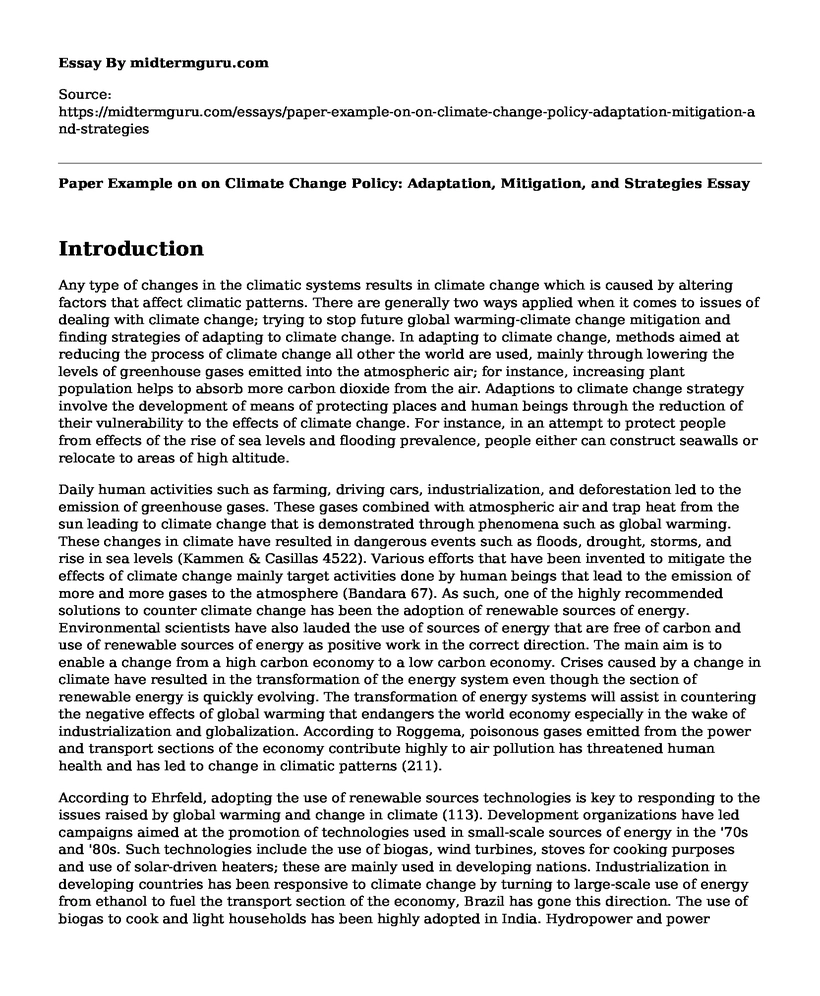Introduction
Any type of changes in the climatic systems results in climate change which is caused by altering factors that affect climatic patterns. There are generally two ways applied when it comes to issues of dealing with climate change; trying to stop future global warming-climate change mitigation and finding strategies of adapting to climate change. In adapting to climate change, methods aimed at reducing the process of climate change all other the world are used, mainly through lowering the levels of greenhouse gases emitted into the atmospheric air; for instance, increasing plant population helps to absorb more carbon dioxide from the air. Adaptions to climate change strategy involve the development of means of protecting places and human beings through the reduction of their vulnerability to the effects of climate change. For instance, in an attempt to protect people from effects of the rise of sea levels and flooding prevalence, people either can construct seawalls or relocate to areas of high altitude.
Daily human activities such as farming, driving cars, industrialization, and deforestation led to the emission of greenhouse gases. These gases combined with atmospheric air and trap heat from the sun leading to climate change that is demonstrated through phenomena such as global warming. These changes in climate have resulted in dangerous events such as floods, drought, storms, and rise in sea levels (Kammen & Casillas 4522). Various efforts that have been invented to mitigate the effects of climate change mainly target activities done by human beings that lead to the emission of more and more gases to the atmosphere (Bandara 67). As such, one of the highly recommended solutions to counter climate change has been the adoption of renewable sources of energy. Environmental scientists have also lauded the use of sources of energy that are free of carbon and use of renewable sources of energy as positive work in the correct direction. The main aim is to enable a change from a high carbon economy to a low carbon economy. Crises caused by a change in climate have resulted in the transformation of the energy system even though the section of renewable energy is quickly evolving. The transformation of energy systems will assist in countering the negative effects of global warming that endangers the world economy especially in the wake of industrialization and globalization. According to Roggema, poisonous gases emitted from the power and transport sections of the economy contribute highly to air pollution has threatened human health and has led to change in climatic patterns (211).
According to Ehrfeld, adopting the use of renewable sources technologies is key to responding to the issues raised by global warming and change in climate (113). Development organizations have led campaigns aimed at the promotion of technologies used in small-scale sources of energy in the '70s and '80s. Such technologies include the use of biogas, wind turbines, stoves for cooking purposes and use of solar-driven heaters; these are mainly used in developing nations. Industrialization in developing countries has been responsive to climate change by turning to large-scale use of energy from ethanol to fuel the transport section of the economy, Brazil has gone this direction. The use of biogas to cook and light households has been highly adopted in India. Hydropower and power connected to the grid system are being highly used to power Nepal economy and therefore have conserved her environment (119).
Conclusion
Climate change has greatly been caused by human activities compared to natural causes. Agricultural activities and industrialization greatly contribute to the production and emission of greenhouse gases that cause global warming. As such, the strategies adopted in this paper to counter the climatic changes due to human activities provide both long-term and short-term solutions to climate change.
Works Cited
Bandara, S. Human Activities and Climate Change. Edmonton: S. Bandara, 2009. Print.
Frass-Ehrfeld, Clarisse. Renewable Energy Sources: A Chance to Combat Climate Change. Alphen aan den Rijn: Kluwer Law International, 2009. Print.
Kammen, D. M. and Top of Form
Casillas, C. E. "The Delivery of Low-Cost, Low-Carbon Rural Energy Services." Energy Policy. 39.8 (2011): 4520-4528. Print.
Roggema, R. Adaptation to climate change: a spatial challenge. Vol. 6. 2009.
Cite this page
Paper Example on on Climate Change Policy: Adaptation, Mitigation, and Strategies. (2022, Oct 13). Retrieved from https://midtermguru.com/essays/paper-example-on-on-climate-change-policy-adaptation-mitigation-and-strategies
If you are the original author of this essay and no longer wish to have it published on the midtermguru.com website, please click below to request its removal:
- Essay on Concern for Environmental Justice
- Essay Example on Oil: A Necessary Evil
- Research Paper on Mosquito Problem in the Ocean Side Community
- Hurricane Scenario - Essay Sample
- Preparing for Disaster: Insurance and Management Plan - Essay Sample
- Population Growth: An Unsustainable Threat to the Environment - Essay Sample
- Haiti Earthquake 2010 - Essay Sample







